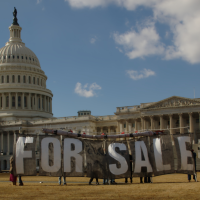Every Member of Congress Elected in 2012 Received Money from at least one of the 31,385 Biggest Donors
 (photo-takomabibelot, flickr)
(photo-takomabibelot, flickr)
A small group of the super-wealthy—literally the top 1% out of the richest 1%—now buy elections and own Congressional representatives the way they buy and own companies or private jets. So in 2012, the first presidential election since the Supreme Court decision in Citizens United v. FEC, not a single member of Congress was able to win election without the financial support of one of these millionaire Machiavellis, according to a report released by good government group the Sunlight Foundation.
In the 2012 election, 28.1% of the nearly $6 billion in donations from identifiable sources came from just 31,385 people: literally one ten-thousandth (0.0001%) of the U.S. population, an elite class that uses its wealth to enforce its self-appointed role as the gatekeepers of public office in 21st century America. The 28.1% figure is the highest in modern history – more than a quarter higher than the previous mark of 21.8%, set in 2006.
Although these totals do not include the $305 million in “dark money” in the 2012 election, whose donors remain anonymous, there is no doubt that dark money donors were also exceptionally wealthy and that their inclusion would make the share of 2012 money coming from the 1% of the 1% even higher.
Who are they? The biggest campaign donors share little in common with the average American. Living in big cities or tony suburbs, they work for highly profitable corporations or private firms, 20% of them in finance, insurance and real estate, and 10% in law or lobbying. Their median donation in 2012 was $26,584, which is more than half of what the average American family earns in a year, and the minimum donation required to make it into the 1% of 1% of political donors was $12,950.
They are also, as their wealth would suggest, more conservative and Republican than most Americans. Despite a media stereotype that mega-donors are political pragmatists who donate to both parties, the report shows that 80% gave all their money to one party or the other. Less than 4% spread their money close to evenly, defined as a 60-40 split or less. The party that benefited most was the Republican Party, as 40% more mega-donors predominantly supported Republicans than predominantly supported Democrats. While 49.8% of the mega-donors gave at least 90% of their money to Republicans, just over 35.5% gave at least 90% to Democrats.
The power of these mega-donors is highlighted by the fact that not only did their money go to every winning congressional candidate last year, but 84% of those elected took more money from the mega-donors than they did from all of their small donors (those who gave $200 or less) combined. Given that winning House members in 2012 raised on average $1.64 million, or about $2,250 per day during their two-year term, and winning senators had to raise $10.3 million, or $14,125 per day, the dependence on mega-donors is easily understood.
If, as the Supreme Court insists, money equals speech, then the speech of the mega-donors is far louder than that of the average American, and creates what law professor Lawrence Lessig has called “dependence corruption”–the way in which the political ideas of the rich become dominant to the exclusion of competing ones simply because wealthy campaign donors demand it and because dollars are more important than votes. The result, as described here a year ago, is a deep divide between voters and elected officials.
-Matt Bewig
To Learn More:
The Political 1% of the 1% in 2012 (by Lee Drutman, Sunlight Foundation)
- Top Stories
- Unusual News
- Where is the Money Going?
- Controversies
- U.S. and the World
- Appointments and Resignations
- Latest News
- Musk and Trump Fire Members of Congress
- Trump Calls for Violent Street Demonstrations Against Himself
- Trump Changes Name of Republican Party
- The 2024 Election By the Numbers
- Bashar al-Assad—The Fall of a Rabid AntiSemite






Comments